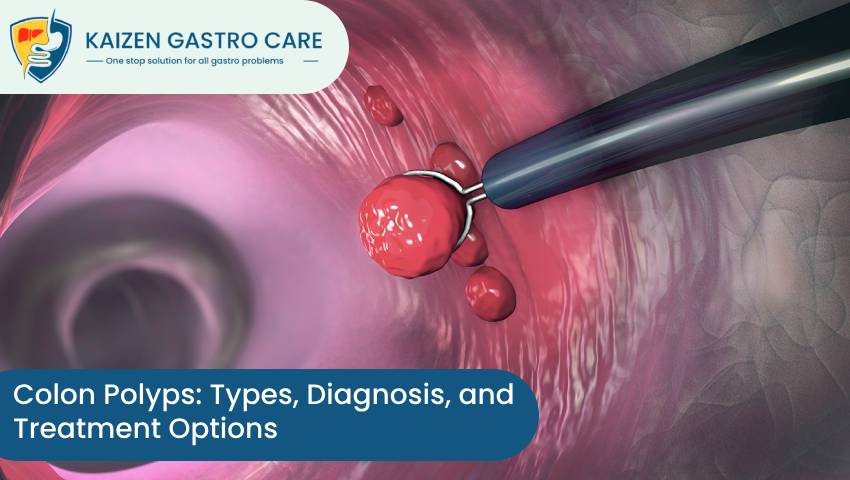
- 22/08/2023
- Kaizen Gastro Care
- 0 Comments
- Proctology
Colon Polyps: Types, Diagnosis, and Treatment Options
Colon health plays a vital role in maintaining overall well-being. One common problem that individuals may encounter is the presence of colon polyps. These abnormal growths on the inner lining of the colon can vary in type and pose potential health risks if left untreated. At Kaizen Gastro Care, a comprehensive approach is taken to manage colon polyps, containing accurate diagnosis and tailored treatment options. This blog delves into the complexities of colon polyps, their types, the diagnostic process, and the range of treatment choices offered by Kaizen Gastro Care.
Understanding Colon Polyps:
Colon polyps are abnormal tissue growths that develop on the inner lining of the large intestine, also known as the colon. These growths can range in size from a small dot to several centimeters in diameter. While most colon polyps are harmless, certain types have the potential to become cancerous over time. The key to effective management lies in earlier detection, precise diagnosis, and proper treatment.
Types of Colon Polyps:
- Adenomatous Polyps: These are the most common type of polyps and are more likely to become cancerous over time. Adenomatous polyps can vary in size and shape, and they are categorized as tubular, tubulovillous, or villous based on their appearance under a microscope.
- Hyperplastic Polyps: These polyps are usually small and rarely grow into cancer. They often arise in the rectum and the left side of the colon. However, a distinct subtype called “serrated adenomas” can carry a higher risk of developing cancer.
- Serrated Polyps: Serrated polyps are a diverse group that contains hyperplastic polyps and sessile serrated adenomas. Some serrated polyps, especially sessile serrated adenomas, have an improved potential to progress to cancer and are often found on the right side of the colon.
Diagnosis of Colon Polyps:
Kaizen Gastro Care employs state-of-the-art diagnostic methods to accurately identify and characterize colon polyps. These diagnostic methods include:
- Colonoscopy: This technique involves using a flexible tube with a camera to examine the inside of the colon. It permits for the direct visualization and potential removal of polyps during the same process.
- Virtual Colonoscopy (CT Colonography): A non-invasive alternative to conventional colonoscopy, CT colonography uses computerized tomography to produce detailed images of the colon. It is especially useful for patients who may not be suitable candidates for conventional colonoscopy.
- Sigmoidoscopy: Similar to colonoscopy, this approach examines the lower portion of the colon and rectum. It is quite effective for detecting polyps in the lower colon.
- Stool Tests: Certain stool tests, like the fecal immunochemical test (FIT), can detect traces of blood in the stool, which may signify the presence of polyps or other abnormalities.
Treatment Options at Kaizen Gastro Care:
The treatment approach for colon polyps at Kaizen Gastro Care is individualized based on the type, size, and location of the polyps, as well as the patient’s overall health. The known treatment options include:
- Polypectomy: During a colonoscopy, polyps can often be removed using technical instruments. This method, known as a polypectomy, not only aids in diagnosis but also controls the potential progression of precancerous polyps.
- Endoscopic Mucosal Resection (EMR): For larger polyps that cannot be completely removed during a normal polypectomy, EMR may be performed. This technique involves the removal of a larger section of tissue from the colon lining.
- Surgery: In cases where polyps are too large, numerous, or present a high risk of cancer, surgical removal of a portion of the colon may be recommended. This is typically performed using minimally invasive techniques to ensure a faster recovery.
- Monitoring and Surveillance: For patients with a history of polyps or those at higher risk, regular colonoscopies may be recommended to monitor for the growth of new polyps or changes in existing ones.
Prevention and Monitoring:
Regular screenings and lifestyle changes can decrease the risk of developing colon polyps. Adopting a diet rich in fruits, vegetables, and whole grains, while limiting red and processed meats, can help. Moreover, maintaining a healthy weight, engaging in regular physical activity, and avoiding smoking and excessive alcohol consumption contributes to overall colon health.
Conclusion:
Colon polyps are a common occurrence that requires careful attention and aggressive management. At Kaizen Gastro Care, a patient-centered approach is taken to manage colon polyps, encompassing accurate diagnosis and tailored treatment options. By staying informed about the types of colon polyps, undergoing regular screenings, and collaborating closely with healthcare professionals, people can take control of their colon health and secure a brighter, healthier future.
